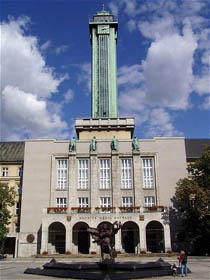
The reconstruction of Masaryk Square in the center of Ostrava has been completed
 |
The square is paved with granite slabs in three shades and marble paving stones. From an aerial view, it creates the optical impression of a Persian carpet with fringes. Between the tiles are chronologically embedded brass plates that remind people of the 30 most significant moments in the history of Ostrava. "The first historical milestone reminds us that mammoth hunters at Landek already burned coal in their fires 25,000 years ago. The last milestone is about the year 1997, when floodwaters caused damages worth 4.5 billion crowns to Ostrava," Arťušenková stated.
In the middle of the square, water rises directly from the pavement to a height of 2.5 meters. The jets of the fountain are placed below the surface, creating an unlimited and traversable fountain. "During the construction of the fountain's machinery and archaeological research, we relocated about 1300 cubic meters of soil," said Jiří Geisler, director of Tchas, to ČTK.
According to archaeologist Michal Zezula, archaeologists uncovered a layer from the time of the city's founding in the 13th century at a depth of two meters. "In the medieval layer, we found, for example, cobblestone paving, metal horse gear, a bit, or bone gaming dice. In the ash layer from the 16th century, we found stove tiles and remnants of a wooden water pipe that brought water to the fountain," he told ČTK. According to him, the most valuable find is a lead pilgrimage badge that someone brought from southern Italy's Bari. An identical specimen was also found years ago in Olomouc.
A restored statue of St. Florian from 1783, which stood there until 1960, should return to the square. The square is adorned with 34 young Japanese zelkova trees, under which it is also possible to sit on benches made of granite and tropical wood. People can refresh themselves at two drinking fountains. "In 1992, the Marian Column from 1702 returned to the square, replacing a statue of a militiaman," said Antonín Barcuch from the city archive to ČTK.
The English translation is powered by AI tool. Switch to Czech to view the original text source.
0 comments
add comment









